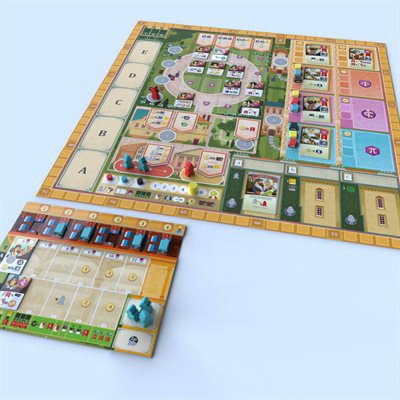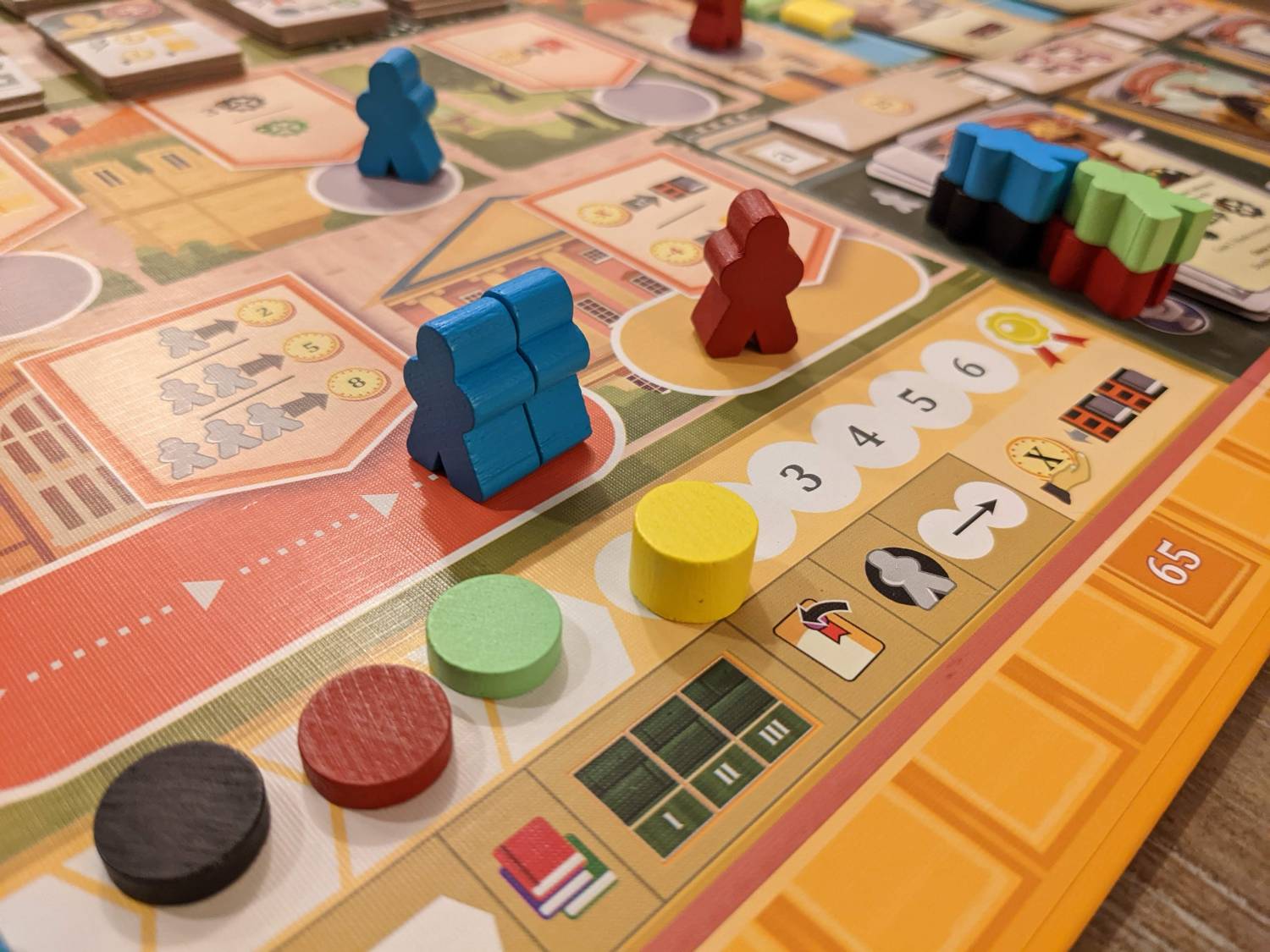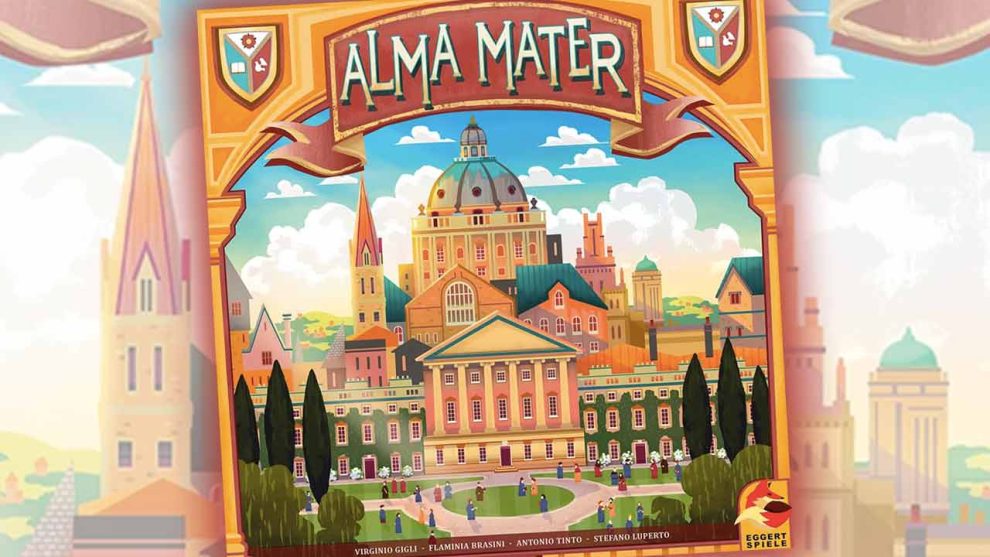Back in the olden times—before COVID—I played a game called Coimbra. Designed by some of the same people who gave us Grand Austria Hotel, Lorenzo il Magnifico, and later Golem, Coimbra checked a lot of boxes for me and has since entered the BGG list of top 200 games.
All those games are Euro efficiency puzzle classics, and while I think Golem is not an all-timer, it’s still pretty strong. After playing Coimbra, I knew I had to pick up Alma Mater (2020, eggertspiele) because I needed to know for myself if that same design team could strike gold again.

Tight on Cash
Alma Mater is a six-round worker placement game. Each round, players will use a pool of 4-6 Masters (workers) to take actions as they try to score the most Prestige Points running a successful university.
Thematically, the game nails a lot of things: you are going to take actions to do research, which in turn will help you sell books that are the most prestigious books in the land thanks to your school’s growing reputation. Your player board is your school, and you’ll slowly add new students to your school each round that will in turn boost your school’s reputation during end-game scoring.
Hiring some of the best professors in the market will also win you greater and greater prestige, and since this is a board game, those professors will also grant once-per-round powers if you can afford the books needed to activate each one of them.
The actions also make sense: you can buy books, hire professors, attract new students, and do more research. Just like in real life, you can use cash to buy your way to fame, thanks to a space that lets you buy seven points if you have enough money lying around. (Again, super thematic.)
However, this is the rub with Alma Mater, a complaint that comes up every time I teach people to play the game: everything is tight, sometimes super tight, on cash. This is especially true if players do not buy your books from your player board, tightening an already tight economy.
(Sure, it’s a Euro, which means you would think you could count on a hefty income each round if your engine is really purring; not in Alma Mater. Sometimes, you might be looking at an income that totals just a couple of “ducats”—coins—each round, which is not enough to do anything meaningful!)

The Real Killer: The Iconography
Don’t worry, I will get back to what shines with Alma Mater, but it is worth noting that as beautiful as the production is with Alma Mater, it is really hard to parse out the iconography in this game.
There are only 16 different students in the game, across four disciplines (math, medicine, etc.). However, every single time I play, I need help with maybe half of the icons on certain student tiles. Ditto for the professors. Even with plain English written on the Chancellor cards—these grant each player a special ability throughout play—sometimes you’ll still need to consult the rulebook to see what each card actually does.
The iconography in Alma Mater is just as difficult as the iconography in Golem, which is hard to believe now that I’ve played both games. Some of it works well—that large green gear means I get a free step on the research track—but most of it requires a deep knowledge of the game to really get it.
Another offender: there’s a space on the player board for sleeping students,but you only need that space if you take a research action that requires you to put one of your Masters to sleep. Taking actions doesn’t make Masters sleepy. They don’t need to be awoken before each new round of play. You might not even have a game where the sleeping action is available because the random research card setup didn’t include that in your game!
That part is too bad, because…

The Production is Amazing
Everything else about Alma Mater’s production feels fantastic. The artwork, with the same artist who designed the characters for Coimbra, is amazing. The box insert is perfect as a storage solution, assuming you don’t store the box on its side. The rulebook feels lavish, and it’s easy to find everything—this is vital, since the iconography can be such a mess.
And those book pieces are THE component of choice from games I played that were released in 2020, bar none. If you have not seen them, you are missing out. They look like books, they sit nicely on your player board’s bookshelf area, they look perfect on the board, they feel great in your hands. Win, win, win, win.
I love the chunk of those student tiles as they are grabbed from the main board and sit comfortably on your player board. The icons that dictate end-round steps are a little better than the ones on cards and tiles, so walking through the end of a round is a cinch.
And even though the teach is a little bumpy, experienced gamers usually pick up how to take actions and have a decent understanding of what some of their consequences might look like. I’ve played this game at 2, 3, and 4 players, and I actually prefer it at two players because an automa is used to fill the third seat, ensuring that there is always a third player. This also ensures a quick playtime, because administering the third player is so easy thanks to the Ignatius card deck (and that Ignatius is almost comically good at running up the research track).
The included variable player power cards (Chancellors) change up your game every time. All of them are good, and almost all of them allow for players to take advantage of those powers right away. There are also nine different mid-game goals to choose from, for three different sections of the board. These goals allow for players to get access to even more of the Chancellors if you can meet those conditions.

Play It, Don’t Buy It
Ultimately, Alma Mater is a game I enjoy, but not one I need to own. In fact, after maybe my fourth play, I sold my copy to a friend of mine. That way, I still have access to it, but it doesn’t take up valuable shelf space.
I’ve played Alma Mater twice since selling my copy, and after a recent game night play where we needed something to fill up two hours, my feelings haven’t changed. Alma Mater doesn’t shine as brightly as Grand Austria Hotel, Lorenzo il Magnifico or Coimbra, but I still enjoy the experience. (One thing I don’t love is the tiebreaker condition. Poor planning around getting cash in the last round of the game???)
These Italian designers are my favorite when it comes to mid-level Euro games. There’s interaction, but it’s mostly a race to score the most points, and the rules overhead is minimal for someone who plays games often. I can teach a game like Grand Austria Hotel to someone in 20 minutes. Alma Mater, and certainly Golem (easily the heaviest of the games I’ve discussed in this piece), are just heavy enough to require a full re-teach if you have not played in a few months.
And, you can still get away with more tactical play and win in games like Coimbra. In Alma Mater, you’ve got to really plan to succeed, so many of my heavy strategy-loving friends enjoy games like Alma Mater. More power to you; I’m sticking to my medium-weight Euro love affair!












Thanks for the great review, Justin. I love this game but can’t lure enough newbies to want to play it with me. I find that if you keep your own bookshelf well-stocked, and have the right players who want to keep the game economy humming by buying each other’s books, money doesn’t become so frustratingly tight. I have enjoyed my 3 player games much more than my 2-player games though. No 4-player games yet.